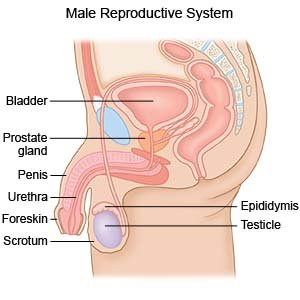Oligoasthenoteratozoospermia
Medically reviewed by Drugs.com. Last updated on Aug 4, 2025.
What is oligoasthenoteratozoospermia (OAT)?
OAT is a condition that includes oligozoospermia (low number of sperm), asthenozoospermia (poor sperm movement), and teratozoospermia (abnormal sperm shape). OAT is the most common cause of male subfertility. Subfertility means a man cannot get a woman pregnant after 1 year of regular sex without birth control.
 |
What causes OAT?
The cause may not be known. The following are possible causes of infertility:
- Medicines such as steroids and medicines used to treat high blood pressure, cancer, or depression may affect your fertility.
- Genetics may cause infertility. This means you may have been born with genes that caused your infertility. Genes may affect sperm production, movement, and transport.
- Abnormal hormone levels may affect sperm production.
- Antibodies may attack your sperm. Antibodies are proteins made by the immune system that attack viruses or bacteria.
- Infections of the male reproductive system, particularly in the prostate, may affect male fertility.
- Lifestyle choices such as smoking, drinking alcohol, and using illegal drugs may affect sperm production.
- A varicocele is a condition that causes the veins in your scrotum to become enlarged and dilated.
What are the signs and symptoms of OAT?
The main sign is that you did not get your partner pregnant after 1 year of regular unprotected sex. Other signs and symptoms will depend on what is causing your infertility. If you have a varicocele, you will have a mass or swelling on the scrotum that feels like a bag of worms.
Related medications
How is OAT diagnosed?
Your healthcare provider will ask about your current health and your health in the past. Your provider may need to know how long you and your partner have been trying to get pregnant. Tell your provider when and how often you have sex, and if you have any problems. You will also be asked if you drink alcohol or smoke, and which medicines you use. You may need any of the following:
- A physical exam will be done. Your healthcare provider will look for signs of any imbalance in your hormones. Examples include increased body fat, body hair, and breast tissue. The size and shape of your testicles will also be examined.
- Blood tests may be done to find the cause of your infertility or to get information about your overall health.
- Genetic tests may be done to look for abnormal genes. Abnormal genes may cause you to produce a low number of sperm.
- A semen analysis is a test used to check a man's fertility. This test may show an increased number of white blood cells in the semen that can cause problems with the sperm's movement and function.
- A sperm analysis tests the movement of your sperm through mucus. Your sperm count may also be measured.
- Spermatic venography is a test to check the position of the veins in the scrotum. During this test, a healthcare provider will put dye into your body and take x-rays to look for a varicocele. Tell the healthcare provider if you have ever had an allergic reaction to contrast dye.
- A scrotal ultrasound is used to find lumps and other changes in your testicles and scrotum, such as a varicocele.
How is OAT treated?
Treatment will depend on the cause of your OAT. You may have any of the following:
- Medicines may be given to treat an infection. Hormones may be used to treat a hormonal imbalance. Steroids may be used to treat infertility caused by an immune system problem. Antioxidants may be suggested by your healthcare provider to decrease damage to sperm caused by reactive oxygen species (ROS). ROS may affect normal sperm function. Antioxidants may include vitamin E, vitamin C, and glutathione.
- Percutaneous embolization is a procedure used to treat a varicocele. The blood flow in the enlarged veins is blocked to stop the flow of blood.
- Sperm extraction is a procedure done to remove sperm from the testicles or epididymis. The collected sperm may be saved or used to fertilize a woman's egg.
- Surgery may be needed to remove a varicocele.
When should I contact my healthcare provider?
- You have swelling or a lump in your scrotum.
- You have pain in the groin area that does not go away.
- You have questions or concerns about your condition or care.
Care Agreement
You have the right to help plan your care. Learn about your health condition and how it may be treated. Discuss treatment options with your healthcare providers to decide what care you want to receive. You always have the right to refuse treatment. The above information is an educational aid only. It is not intended as medical advice for individual conditions or treatments. Talk to your doctor, nurse or pharmacist before following any medical regimen to see if it is safe and effective for you.© Copyright Merative 2025 Information is for End User's use only and may not be sold, redistributed or otherwise used for commercial purposes.
Further information
Always consult your healthcare provider to ensure the information displayed on this page applies to your personal circumstances.
